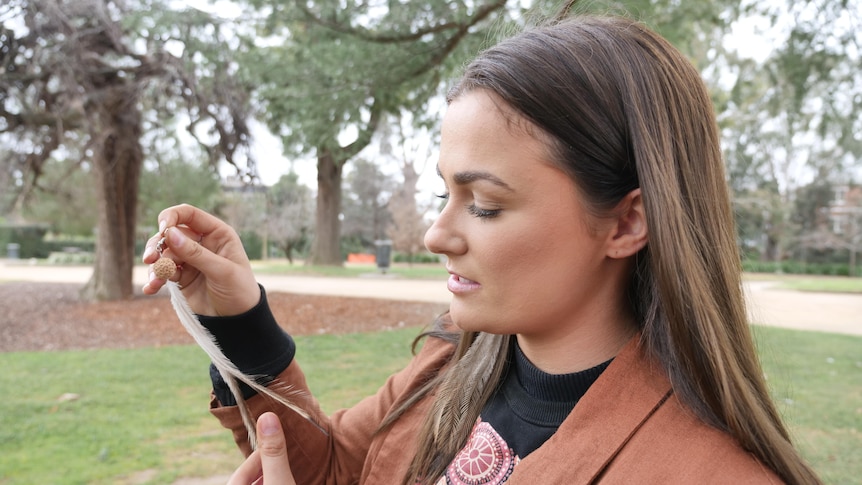Amy Daniel grew up with constant questions about her heritage and culture, something she still faces to this day.
“A lot of people question me and say, ‘You’re too white to be Aboriginal. You’re too pretty to be Aboriginal. You don’t speak like one’,” she said.
She said initially it made her angry and left her questioning herself, but now she used it to educate others.
“I take that opportunity to teach people that no matter how much milk you put in a cup of tea, you’re still a bit black on the inside.”
The 23-year-old Nukunu woman first found out she was Indigenous while in high school.
She was born and raised in Queanbeyan but her descendants are from Nukunu country, near Port Augusta in South Australia.
Ms Daniel recently began connecting more deeply to her culture after moving to Wagga Wagga, in southern New South Wales.
“I grew up painting a lot so I found a bit of a connection there and loved learning more about my culture,” she said.
“Then I moved here [Wagga Wagga]. I met a few of our friends and they taught me more about the importance of being on country.
“They’re helping me find my way and helping me find my story.”
a long journey
Ms Daniel always felt a sense of connection to her Indigenous roots.
“When I do things on country, when I paint, when I make jewelery and weave, I am so calm and peaceful,” she said.
“My mum always said when I was growing up [that] I was the most impatient person ever.
“But she was amazed that I’d sit down for six hours straight and do 1,000 dots on a piece of paper without moving.”
But Ms Daniel said connecting to her culture has come with its challenges, such as being questioned because of the color of her skin.
She said it had also been difficult to connect to culture, because she did not grow up on Nukunu country and was not exposed to it from a young age.
“Now I wish I would’ve seen more stories or read more about young ladies or men who are on the fairer skin side, and read about their journey into finding their culture,” she said.
“Maybe even doing it with someone and knowing that you’re not really alone.”
Reconnecting to ‘vital’ culture
Ms Daniel is not alone in her journey to connect to culture.
The Coota Girls Aboriginal Corporation has been helping descendants of Stolen Generations survivors reconnect to their culture.
It has managed a project, called Nurture Our Youth, to address intergenerational trauma caused by the forced removal and institutionalization of family members.
Wailwan and Gamilaroi woman Meagan Gerrard’s grandmother was in the Cootamundra Domestic Training Home for Aboriginal Girls, in southern NSW, for almost 15 years.
Ms Gerrard said practicing culture was forbidden in the home, which impacted generations to come.
“So much was taken from us — we lost language, we lost that connection to culture,” she said.
“That journey back to reconnecting to those vital things as Aboriginal people, it’s a hard journey.”
Ms Gerrard said the project would allow descendants to take part in cultural gatherings, which involved activities like weaving, eating bush tucker and yarning.
“To support them to reconnect to culture, to learn language, and to come together as a community,” she said.
“To embrace that would be such a powerful thing for them to experience.”
.
